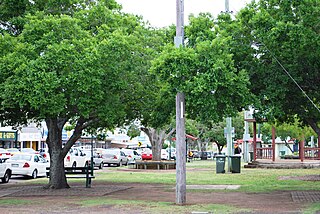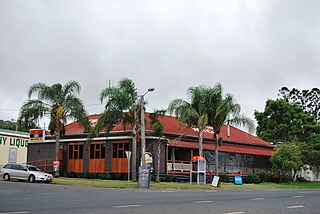
Murgon is a rural town and locality in the South Burnett Region, Queensland, Australia. In the 2021 census, the locality of Murgon had a population of 2,220 people.

Booubyjan is a rural locality in the Gympie Region, Queensland, Australia. In the 2021 census, Booubyjan had a population of 98 people.

Kilkivan is a rural town and locality in the Gympie Region of Queensland, Australia. In the 2021 census, the locality of Kilkivan had a population of 689 people.

Goomeri is a rural town and locality in the Gympie Region, Queensland, Australia. In the 2021 census, the locality of Goomeri had a population of 677 people.

Tingoora is a rural town and a locality in the South Burnett Region, Queensland, Australia.

Theebine is a rural town and locality split between the Gympie Region and the Fraser Coast Region, both in Queensland, Australia.

Woolooga is a rural town and locality in the Gympie Region, Queensland, Australia. In the 2021 census, the locality of Woolooga had a population of 310 people.

The Nanango railway line was a narrow-gauge branch railway located in Queensland, Australia. On 31 October 1882, parliament approved the construction of a branch line from Theebine west to Kilkivan after gold and copper were discovered in this region of Queensland, Australia. The section was opened in two stages – to Dickabram on 1 January 1886 after two crossings of the Mary River and to Kilkivan on 6 December 1886.

Wide Bay–Burnett is a region of the Australian state of Queensland, located between 170–400 km (110–250 mi) north of the state capital, Brisbane. The area's population growth has exceeded the state average over the past 20 years, and it is forecast to grow to more than 430,000 by 2031. It is the subject of the Draft Wide Bay–Burnett Regional Plan, which aims to facilitate this growth while protecting over 90% of the region from urban development.
The Kilkivan to Kingaroy Rail Trail is an 88-kilometre (55 mi) recreation trail from Kilkivan to Kingaroy. The trail follows the old Kingaroy Branch railway and is open to walkers, cyclists and horse riders.
Windera is a town in the South Burnett Region and a locality split between the South Burnett Region and the Gympie Region in Queensland, Australia. In the 2021 census, the locality of Windera had a population of 105 people.

Boonara is a rural locality in the Gympie Region, Queensland, Australia. In the 2021 census, Boonara had a population of 60 people.

Cinnabar is a rural locality in the Gympie Region, Queensland, Australia. In the 2021 census, Cinnabar had a population of 83 people.

Kinbombi is a rural town and locality in the Gympie Region, Queensland, Australia. In the 2021 census, the locality of Kinbombi had a population of 34 people.
Redgate is a rural locality in the South Burnett Region, Queensland, Australia. In the 2021 census, Redgate had a population of 94 people.

Tansey is a rural town and locality in the Gympie Region, Queensland, Australia. In the 2021 census, the locality of Tansey had a population of 154 people.
Sexton is a rural locality in the Gympie Region, Queensland, Australia. In the 2021 census, Sexton had a population of 187 people.
Goomeribong is a rural locality in the Gympie Region, Queensland, Australia. In the 2021 census, Goomeribong had a population of 49 people.
Paterson is a rural locality in the Fraser Coast Region, Queensland, Australia. In the 2021 census, Paterson had a population of 157 people.
Byee is a rural locality in the South Burnett Region, Queensland, Australia. In the 2021 census, Byee had a population of 39 people.















